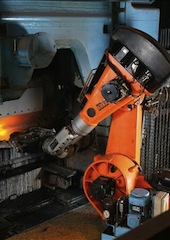What Happens When the Robots Take Over?
A reflection on human ingenuity and production.
February 4, 2014

The move to a world of robots has been slower than the 1950s expected. On the one hand, Moore’s Law, doubling the capacity and speed of computer operations every two years, has been fully in operation since that time. On the other hand, many quite simple operations are in fact very difficult indeed for robots to carry out.
For example, according to the new book “The Second Machine Age” by MIT professors Erik Brynjolfsson and Andrew McAfee, it currently takes a robot fully 24 minutes to fold a towel.
This makes robots a lot less useful than they might be. The Jetsons’ world of a universal robot housemaid is still decades away — if it takes robots 24 minutes to fold a towel, it presumably takes them several hours to make a bed properly. And it would take days upon days to clear up the living room after the kids have been through.
We are therefore reduced for the foreseeable future to the simple iRobot Roomba, an admirable machine that is nevertheless capable only of vacuuming the apartments of compulsive neat-freaks who don’t scatter junk about.
Getting closer — or farther?
Still, there is good news for harried homeowners: the move to a “Jetsons” robot housemaid is only a matter of time. If the robot that takes 24 minutes to fold a towel simply undergoes a few more iterations of Moore’s Law, after 10 more iterations, in 2034, the robot will be able to fold a towel in 1/1,024 of its present time, or 1.4 seconds.
Before rejoicing at the future capabilities available to us, we should however remember the Great Moore’s Law Compensator, propounded by Niklaus Wirth in 1995. It says that software is growing more sluggish and complex faster than computer power is increasing.
For example, according to a 2008 InfoWorld article, the 2007 version of Microsoft Office performed approximately half as fast on a 2007 computer as the 2000 version did on a 2000 computer. Thus, the entry into robot bliss is not guaranteed.
One million monkeys on typewriters
Even today, for all the progress we’ve seen, productivity has advanced less than you think. The great Earl of Clarendon compiled his magnificent “History of the Great Rebellion” of about 1.2 million words, plus a 3-volume autobiography, an excellent refutation of Hobbes’ “Leviathan” and several other books.
He wrote a total of about two million carefully researched words, almost entirely in the seven years before he died. The Earl worked with a quill pen, in candlelight, while moving from one temporary exile abode to another. He was also haunted by the illnesses of old age and 17th century medicine.
Given the amount of learning involved and the quality of the prose, there is no modern writer who could do as well, even with all available modern equipment.
While a computer could certainly compose two million words in half an hour or so, they would be rubbish. Its output would be little better than the output of the proverbial million monkeys on typewriters.
Dr. Watson
One area where future robots may provide major productivity lifts, however, is medicine. IBM is already attempting to turn Watson into “Dr. Watson,” capable of undertaking medical diagnosis. Storing theoretical knowledge is of course no problem here. The difficulty is applying that knowledge to individual cases.
Once diagnosis is possible, one can imagine robots undertaking surgery — presumably only after they have got towel folding down cold. There are a number of mechanical operations in surgery that one would not wish carried out at one hundredth the normal speed.
But what about the unemployment problem?
The key to avoiding unemployment from automation will be using robots and humans in combination on tasks where neither alone is as effective or efficient as both together.
As robots take over household and low-wage tasks such as janitorial services, landscaping, food service and low-end retail, people can be attached to the robots in areas where a robot-human combination is optimal.
However, there are almost certainly far too many humans for this to work. In a modern factory, one human will be able to supply the “human factor” for a dozen robots or more. This leaves a huge surplus of unemployed labor.
Once again, as in so many other areas of human activity, when one looks forward, one is forced to the conclusion that a fully-deployed system of robots will only work properly with a population perhaps one tenth of that today. They would, of course, be incomparably affluent, with ubiquitous robot production of necessities, services and many luxuries..
In other words, for a robotized world to be contented, we must go back to the one billion humans the planet held in 1800. Maybe the population increase that accompanied industrialization isn’t permanently sustainable after all, but merely a giant blip.
A more creative future
The economic disruption will be considerable, but I refuse to believe we will enter a world where four-fifths of the population lives on welfare while the other fifth pay 90% income taxes to support them.
Instead, just as the rise of surplus agriculture allowed for some in early societies to explore creative careers, I think arts and crafts will support far more of us than they do today. Meanwhile, others will work with the robots and a small group will push forward the technological frontiers or engage in entrepreneurship.
It will be a more prosperous world if we have fewer people. But that too is a problem that will eventually solve itself peacefully, as necessity creates new incentives and opportunities.
Just as crowding and scarce jobs pushed settlers to leave the Old World for the Americas, perhaps the fulfillment of the dream of automation — and accompanying employment concerns — will spur on the dream of colonizing of other planets.
Takeaways
For a robotized world to be contented, we must go back to the 1 billion humans the planet held in 1800.
The Jetsons’ world of a universal robot housemaid is still decades away.
If it takes robots 24 minutes to fold a towel, it presumably takes them several hours to make a bed properly.
After 10 more iterations of Moore’s Law, in 2034, a robot will be able to fold a towel in 1/1,024 of its time now.
We should remember the Great Moore's Law Compensator, propounded by Niklaus Wirth in 1995.
Software is growing more sluggish and complex faster than computer power is increasing.
One area where future robots may provide major productivity lifts is medicine.
IBM is already attempting to turn Watson into "Dr. Watson," capable of undertaking medical diagnosis.
Read previous

America’s False Dawn
February 4, 2014